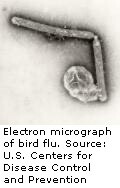
WEDNESDAY, May 2 (HealthDay News) — Data in a formerly banned study detailing how the H5N1 avian (bird) flu virus can morph — with the possibility that it could spread from person to person and cause a global pandemic — may help nations prepare for the impending threat.
That’s some of the motivation for lifting the ban and publishing the study in the May 2 online issue of Nature, experts say.
The initial ban applied to two studies slated to be published in two medical journals, Nature and Science. In December, the U.S. government intervened, requesting that both journals censor some of the data for national security purposes. The concern was that terrorists might use the information to create a lethal biological weapon.
The ban was lifted in April, after the U.S. government conducted a risk assessment in March. Nature also commissioned an independent assessment. Both showed that publication would confer more public benefit than risk.
In the Nature study, Yoshihiro Kawaoka, a professor of virology at the University of Wisconsin-Madison, and colleagues tweaked the H5N1 virus using genetic material borrowed from H1N1 ‘swine’ flu to see if it would transmit easily between ferrets — an animal model thought to be closely related to humans.
It did.
These genetic changes can make the virus easier to transmit, the study found. Knowing their footprints can help researchers know what to look out for and hopefully catch the virus early before it begins to spread.
“H5N1 viruses remain a significant threat for humans as a potential pandemic flu strain,” Kawaoka said. “We have found that relatively few mutations enable this virus to transmit in mammals.”
The information provided by this study is important as the virus could mutate on its own. Now “we can better prepare should a pandemic virus emerge in nature,” Kawaoka said. Currently available vaccines and antivirals are effective treatments for this engineered virus.
“Stockpiling H5N1 vaccines and antivirals will be important for pandemic preparedness,” he said, and flu trackers too can use this information when they develop vaccines in the future. “Just as for a seasonal flu vaccine, it will be important for an H5N1 vaccine to be made to a closely related virus, so knowing which mutations may confer transmissibility will help prioritize vaccine candidates,” Kawaoka explained.
The new data also help advance science by increasing the understanding of the basic biology of flu transmission. “Sharing the data with other scientists will lead to important additional discoveries that may aid the development of improved vaccines and therapeutics,” Kawaoka said.
There had been doubt that the bird flu could mutate and cause a pandemic, said microbiologist Joseph Sriyal Malik Peiris, of the University of Hong Kong. He was a co-author of a journal editorial accompanying the new study. He said this research does suggest that bird flu can mutate. “It suggests that the H5N1 virus can potentially acquire transmissibility in humans. However, whether it will ever do so is another matter.”
While there have been sporadic cases of bird flu in humans, these have been traced to people directly handling live birds, for instance while working in a poultry market.
Importantly, this research and its publication are not a threat to U.S. security, Peiris said. “This research only tells us that the mutated H5N1 transmits in ferrets. It also tells us that the mutated virus no longer kills ferrets,” he said. “Why would anyone who wanted to ‘create harm’ put so much effort into generation of such a virus with so much uncertainty on how it would work in practice?”
But, Peiris noted, the study “is important for pandemic risk assessment because it gives indications of the mutations that we should be watching out for.”
Dr. Bruce Hirsch, an infectious diseases specialist at North Shore University Hospital in Manhasset, N.Y., agreed that publication is likely to do more good than harm. “We should be aware of the fact that this influenza can mutate,” he said. “Publication makes us safer because we know what to look out for now. This can help facilitate preventive strategies and can eventually lead to more effective vaccine development and antiviral therapy.”
He added, “We live in a much smaller world because of air travel and population density and certainly we are more vulnerable to viruses as a result.”
This virus is not likely to be used by terrorists to cause a pandemic, Hirsch said. “It became less lethal in the animal model. I am reassured by the fact that the ability to make it a ‘terror’ virus has not really been demonstrated.”
More information
Learn more about bird flu at the U.S. Centers for Disease Control and Prevention.

